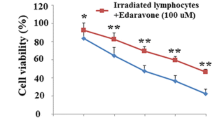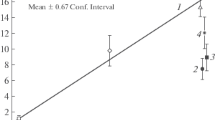Purpose:
The authors investigated whether a potential radioprotective effect of amifostine (WR-2721) after in vitro or in vivo administration can be detected with the comet assay. Moreover, it was determined whether radioprotection by WR-2721 is dependent on the concentration of amifostine or alkaline phosphatase (AP, the enzyme which activates the prodrug). Furthermore, the authors tried to detect possible interindividual differences in radioprotection by amifostine.
Material and Methods:
In vitro administration of amifostine: Freshly isolated lymphocytes from two healthy volunteers were incubated with different concentrations of AP (0–210 U/ml) and amifostine (0–5,000 µg/ml). In vivo administration of amifostine: Blood samples were collected from six postoperative rectal cancer patients before and after intravenous administration of amifostine 500 mg (no pretreatment with radio- or chemotherapy). Leukocytes and lymphocytes were irradiated and repaired in vitro and investigated with the alkaline comet assay. The radioprotective effect was evaluated by calculating dose-modifying factors (DMFs) and the paired t-test.
Results:
Amifostine alone did not alter the radiation-induced DNA damage in vitro. The addition of at least 0.5–1 U/ml AP was required. A significant radioprotective effect (p < 0.05) was seen after administration of amifostine in vitro for all concentrations investigated (250–5,000 µg/ml, initial DNA damage). A comparable radioprotective effect after in vivo administration of 500 mg amifostine was measured with a mean DMF of 0.87. Interindividual differences were present in vivo and in vitro.
Conclusion:
Amifostine 500 mg intravenously yields an adequate radioprotective concentration. The effect was only marginally improved by extreme concentrations of amifostine in in vitro experiments. The comet assay is capable of detecting small changes in radiosensitivity by amifostine.
Ziel:
Die Autoren untersuchten, ob ein potentieller radioprotektiver Effekt von Amifostin (WR-2721) nach In-vitro- und In-vivo-Gabe mit dem Comet-Assay detektierbar ist. Zudem wurde überprüft, ob eine Abhängigkeit der Radioprotektion durch WR-2721 von den Konzentrationen an Amifostin und alkalischer Phosphatase (AP, das Enzym, welches das Prodrug aktiviert) besteht. Des Weiteren wurde die Radioprotektion durch Amifostin bezüglich möglicher vorhandener interindividueller Unterschiede untersucht.
Material und Methodik:
In-vitro-Applikation von Amifostin: Frisch isolierte Lymphozyten zweier gesunder Spender wurden bei unterschiedlichen Konzentrationen von AP (0–210 U/ml) und Amifostin (0–5 000 µg/ml) inkubiert. In-vivo-Applikation von Amifostin: Untersucht wurden Leukozyten von sechs postoperativen Rektumkarzinompatienten vor und nach Infusion von 500 mg Amifostin (ohne radio- oder chemotherapeutische Vorbehandlung). Leukozyten und Lymphozyten wurden in vitro bestrahlt und repariert sowie mit dem alkalischen Comet-Assay ausgewertet. Zur Beurteilung der radioprotektiven Wirkung wurden dosismodifizierende Faktoren (DMF) berechnet und der gepaarte t-Test durchgeführt.
Ergebnisse:
Der DNA-Schaden nach Bestrahlung wurde durch alleinigen Zusatz von Amifostin in vitro nicht verändert. Die Zugabe von mindestens 0,5–1 U/ml AP war erforderlich. Ein signifikanter radioprotektiver Effekt (p < 0,05) bestand nach Applikation aller untersuchten Amifostinkonzentrationen in vitro (250–5 000 µg/ml, Initialschäden). Ein vergleichbarer radioprotektiver Effekt wurde nach In-vivo-Gabe von 500 mg Amifostin mit einem mittleren DMF von 0,87 gemessen. Interindividuelle Unterschiede bestanden sowohl in vitro als auch in vivo.
Schlussfolgerung:
500 mg Amifostin intravenös sind eine adäquate radioprotektive Dosis. Die Wirkung ließ sich in vitro selbst bei extremen Amifostinkonzentrationen nur marginal steigern. Der Comet-Assay ist geeignet, kleine Veränderungen der Radiosensitivität durch Amifostin zu quantifizieren.
Similar content being viewed by others
Author information
Authors and Affiliations
Corresponding author
Rights and permissions
About this article
Cite this article
Müller, AC., Pigorsch, S., Beyer, C. et al. Radioprotective Effects of Amifostine In Vitro and In Vivo Measured with the Comet Assay. Strahlenther Onkol 180, 517–525 (2004). https://doi.org/10.1007/s00066-004-1216-3
Received:
Accepted:
Issue Date:
DOI: https://doi.org/10.1007/s00066-004-1216-3




